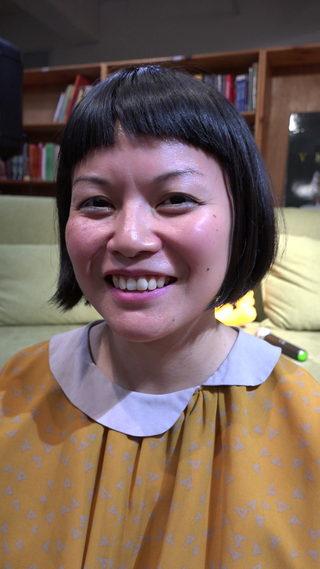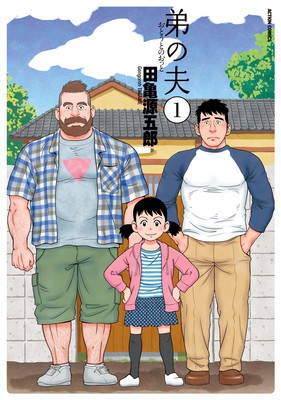Related Research Articles

G-men is a Japanese gay lifestyle brand, and formerly a monthly magazine.

Gengoroh Tagame is a pseudonymous Japanese manga artist. He is regarded as the most prolific and influential creator in the gay manga genre. Tagame began contributing manga and prose fiction to Japanese gay men's magazines in the 1980s, after making his debut as a manga artist in the yaoi manga magazine June while in high school. As a student he studied graphic design at Tama Art University, and worked as a commercial graphic designer and art director to support his career as a manga artist. His manga series The Toyed Man, originally serialized in the gay men's magazine Badi from 1992 to 1993, enjoyed breakout success after it was published as a book in 1994. After co-founding the gay men's magazine G-men in 1995, Tagame began working as a gay manga artist full-time.

Erotic comics are adult comics which focus substantially on nudity and sexual activity, either for their own sake or as a major story element. As such they are usually not permitted to be sold to legal minors. Like other genres of comics, they can consist of single panels, short comic strips, comic books, or graphic novels/albums. Although never a mainstream genre, they have existed as a niche alongside – but usually separate from – other genres of comics.
Sadao Hasegawa was a Japanese graphic artist known for creating homoerotic fetish art. His works are noted for their extensive detail, elaborate fantasy settings, and for their juxtaposition of elements from Japanese, Balinese, Thai, Tibetan Buddhist, African, and Indian art. While Hasegawa focused primarily on depictions of muscular male physique, he often incorporated extreme sexual themes in his works, including bondage and sadomasochism. His art is noted for strong mystical and spiritual overtones.
Bara is a colloquialism for a genre of Japanese art and media known within Japan as gay manga (ゲイ漫画) or gei komi. The genre focuses on male same-sex love, as created primarily by gay men for a gay male audience. Bara can vary in visual style and plot, but typically features masculine men with varying degrees of muscle, body fat, and body hair, akin to bear or bodybuilding culture. While bara is typically pornographic, the genre has also depicted romantic and autobiographical subject material, as it acknowledges the varied reactions to homosexuality in modern Japan.

Megumi Igarashi, who uses the pseudonym Rokudenashiko, is a Japanese sculptor and manga artist who creates works that feature female genitalia and are often modeled after her own vulva. Rokudenashiko considers it her mission to reclaim female genitalia as part of women's bodies and demystify them in Japan's male dominated society, where she believes that they are "overly hidden" and marginalized as “taboo” and “obscene” in comparison to phallic imagery. As such, the artist has created a variety of different representations of manko, the Japanese slang for vagina or pussy, using representations of her own body as the raw material to emphasize as return to experience within art and manga. Rokudenashiko has been called an international symbol of “manko positivity.”

Anne Ishii is an American writer, editor, translator, and producer based in Philadelphia. Ishii is the host of WHYY's Movers & Makers, and the Executive Director of Philadelphia's Asian Arts Initiative, an arts non-profit.

My Brother's Husband is a manga series by Gengoroh Tagame. Serialized in Monthly Action from 2014 to 2017, and adapted into a live-action television drama by NHK in 2018, the series follows the relationship between single father Yaichi, his daughter Kana, and Mike Flanagan, the Canadian husband of Yaichi's estranged and recently deceased twin brother.
Massive Goods is a fashion brand and manga publisher. The company works with LGBTQ and feminist comic artists in Japan, particularly gay manga (bara) artists, to create products featuring their artwork, and English-language translations of their works.
Jiraiya is a pseudonymous Japanese gay manga artist and illustrator. He is noted for his homoerotic, hyperreal drawings of gachimuchi men, and for his use of digital illustration in his artwork.
Sanshi Funayama was a Japanese homoerotic fetish artist. Funayama, along with Go Mishima, Tatsuji Okawa, and Go Hirano, is regarded by artist and historian Gengoroh Tagame as a central figure in the first wave of contemporary gay artists in Japan.
Tatsuji Okawa was a Japanese homoerotic fetish artist. Tatsuji, along with Go Mishima, Sanshi Funayama, and Go Hirano, is regarded by artist and historian Gengoroh Tagame as a central figure in the first wave of contemporary gay artists in Japan.
Go Hirano (平野剛) was a Japanese homoerotic fetish artist. Hirano, along with Go Mishima, Sanshi Funayama, and Tatsuji Okawa, is regarded by artist and historian Gengoroh Tagame as a central figure in the first wave of contemporary gay artists in Japan.

Queer Japan is a 2019 documentary film directed, edited, and co-written by Graham Kolbeins. The documentary profiles a range of individuals in Japan who identify as lesbian, gay, bisexual, transgender, and queer (LGBTQ). Queer Japan is produced by Hiromi Iida with Anne Ishii, written by Ishii and Kolbeins, and features an original score composed by Geotic.
Ben Kimura was a Japanese gay erotic artist. Kimura, along with George Takeuchi and Sadao Hasegawa, is noted by artist and historian Gengoroh Tagame as a central figure in the second wave of contemporary gay artists that emerged in Japan in the 1970s.

Our Colors is a Japanese manga series written and illustrated by Gengoroh Tagame. It was serialized in Futabasha's Monthly Action magazine from March 2018 to May 2020 and collected into three tankōbon volumes. Our Colors is Tagame's second manga for general audiences, following his 2014 series My Brother's Husband. The series follows Sora Itoda, a closeted second-year high school student, who is alienated by the homophobia of his peers and the pressures of needing to pass as straight. One day, Sora meets an older man who runs a cafe, and learns that the man is also gay. The series follows the intergenerational friendship that forms between Sora and the man, and the mentorship the man provides Sora on the problems he is facing.

Massive: Gay Erotic Manga and the Men Who Make It is a 2014 manga anthology edited by Anne Ishii, Chip Kidd, and Graham Kolbeins, and published by Fantagraphics Books. Collecting works from Gengoroh Tagame, Jiraiya, and numerous other artists, it is the first English-language anthology of gay manga.
Takeshi Matsu is a Japanese gay manga artist.
Gai Mizuki, also known as Rycanthropy, is a Japanese gay manga artist and dōjin soft producer.
References
- ↑ Thibault, Simon (September 14, 2012). "Rad Queers inspire and delight". Daily Xtra . Retrieved June 11, 2017.
- ↑ Kolbeins, Graham (February 5, 2014). "Rad Queers: Edie Fake". The Comics Journal . Retrieved June 11, 2017.
- ↑ Mixner, David (January 20, 2013). "VIDEO: Payasos L.A. Is An Organization of Latino Gay Men Giving Back To the Community!". DavidMixner.com . Retrieved June 11, 2017.[ permanent dead link ]
- ↑ "MASSIVE – Documents Japan's Historic House of Gay Art (Watch)". LGBT Update. February 28, 2015. Retrieved June 11, 2017.
- ↑ "Massive's pilgrimage to The House of Gay Art". Last Gasp . Retrieved June 11, 2017.
- ↑ Rondinelli, David (March 5, 2015). "EXCLUSIVE INTERVIEW WITH MASSIVE CREATIVE DIRECTOR GRAHAM KOLBEINS". Geeks OUT . Retrieved June 11, 2017.[ permanent dead link ]
- ↑ "About". MASSIVE Goods . Retrieved June 11, 2017.
- ↑ Trebay, Guy (June 23, 2014). "Opening Ceremony Turns to Manga Comic Artist for Gay Pride Week". The New York Times . Retrieved June 11, 2017.
- ↑ @Mishka_LA (May 11, 2015). "This Friday from 7–10 PM Gengoroh Tagame will b here showing his artwork & doing an in-store book signing! Come hang!" (Tweet). Retrieved June 11, 2017– via Twitter.
- ↑ "JUSFC Meet Our Grantees Series: Graham Kolbeins – Writer, Designer, Film Maker". Japan-United States Friendship Commission . December 16, 2016. Retrieved June 11, 2017.
- ↑ Nichols, James Michael (February 20, 2016). "Get An Intimate Look at Queer Life in Japan". Huffington Post . Retrieved June 11, 2017.
- ↑ Aoki, Deb (March 7, 2016). "Interview: "Queer Japan" Filmmaker Graham Kolbeins". Anime News Network . Retrieved June 11, 2017.
- 1 2 ""Queer Japan" Post-Production". GoFundMe . Retrieved June 11, 2017.
- ↑ "Rafa Esparza". grahamkolbeins.com. Retrieved June 11, 2017.[ permanent dead link ]
- ↑ "Dorian Wood". grahamkolbeins.com. Retrieved June 11, 2017.
- ↑ Kay, Jean (February 25, 2015). "An interview with Beau Rice". AQNB. Retrieved June 11, 2017.
- ↑ Stewart, Dodai (June 10, 2013). "Are You Going to Eat That? Pretty Little Liars Has Food Issues". Jezebel . Retrieved June 11, 2017.
- ↑ Gray, Emma (June 11, 2013). "'Pretty Little Liars' Food Horror Video Reveals The Show's Eating Issues". Huffington Post . Retrieved June 11, 2017.
- ↑ Thorne, James (April 30, 2013). "The Passion of Gengoroh Tagame". Cool Hunting. Retrieved June 11, 2017.
- ↑ Greenwell, Garth (December 8, 2013). "Gengoroh Tagame's 'The Passion of Gengoroh Tagame: Master Of Gay Erotic Manga': Book Review". Tower Road. Retrieved June 11, 2017.
- ↑ Cardamone, Tom (November 30, 2013). "'The Passion of Gengoroh Tagame: Master of Gay Erotic Manga' by Gengoroh Tagame". Lambda Literary Foundation . Retrieved June 11, 2017.
- ↑ Nichols, James (February 2, 2015). "'Massive: Gay Erotic Manga And The Men Who Make It,' Chronicles Gay Japanese Manga". Huffington Post . Retrieved June 11, 2017.
- ↑ Cardamone, Tom (January 13, 2015). "'Massive: Gay Erotic Manga and the Men Who Make It' Edited by Graham Kolbeins, Anne Ishii, and Chip Kidd". Lambda Literary Foundation . Retrieved June 11, 2017.
- ↑ Cummins, Chris (February 2, 2015). "Massive: An Interview With Comics Historian Graham Kolbeins". Den of Geek! . Retrieved June 11, 2017.
- ↑ Asselin, Janelle (April 22, 2015). "2015 Eisner Award Nominations Announced". ComicsAlliance . Retrieved June 11, 2017.
- ↑ Saba, Oliver (May 13, 2016). "What Is Obscenity? seeks to liberate the vagina through art activism". The A.V. Club . Retrieved June 11, 2017.
- ↑ Kirby, Robert (April 28, 2016). "What Is Obscenity? The Story of a Good for Nothing Artist and Her Pussy". The Comics Journal . Retrieved June 11, 2017.
- ↑ Schaub, Michael (February 22, 2017). "L.A. Times Book Prize finalists include Zadie Smith and Rep. John Lewis; Thomas McGuane will be honored". Los Angeles Times . Retrieved June 11, 2017.